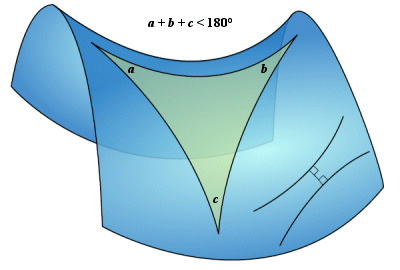1825
$$
\oint_{\gamma} f(z) d z=0
$$
Cauchy’s integral formula, named after Augustin-Louis Cauchy, is a central statement in complex analysis. It expresses the fact that a holomorphic function defined on a disk is completely determined by its values on the boundary of the disk, and it provides integral formulas for all derivatives of a holomorphic function. Cauchy’s formula shows that, in complex analysis, “differentiation is equivalent to integration”: complex differentiation, like integration, behaves well under uniform limits – a result that does not hold in real analysis.
1829 1832
$$
A=\pi-\alpha-\beta-\gamma
$$
In mathematics, non-Euclidean geometry consists of two geometries based on axioms closely related to those that specify Euclidean geometry. As Euclidean geometry lies at the intersection of metric geometry and affine geometry, non-Euclidean geometry arises by either relaxing the metric requirement, or replacing the parallel postulate with an alternative.
Between 1820 and 1823, János Bolyai, a Hungarian mathematician, prepared, but did not immediately publish, a treatise on a complete system of non-Euclidean geometry.
Completely independent from Bolyai, in the distant provincial Russian city of Kazan, Nikolai Ivanovich Lobachevsky had also been working, along very similar lines as Bolyai, to develop a geometry in which Euclid’s fifth postulate did not apply. His work on hyperbolic geometry was first reported in 1826 and published in 1830, although it did not have general circulation until some time later.
This early non-Euclidean geometry is now often referred to as Lobachevskian geometry or Bolyai-Lobachevskian geometry, thus sharing the credit.

1838
$$
\frac{d N}{d t}=r N\left(1-\frac{N}{K}\right)
$$
Pierre François Verhulst developed the logistic function in a series of three papers between 1838 and 1847, based on research on modeling population growth that he conducted in the mid 1830s, under the guidance of Adolphe Quetelet.
The concept of R/K selection theory derives its name from the competing dynamics of exponential growth and carrying capacity.
1822 1842
$$
\frac{\partial u}{\partial t}+u \cdot \nabla u=-\frac{1}{\rho} \nabla p+v \nabla^{2} u+g
$$
In physics, the Navier–Stokes equations (/nævˈjeɪ stoʊks/) are a set of partial differential equations which describe the motion of viscous fluid substances, named after French engineer and physicist Claude-Louis Navier and Anglo-Irish physicist and mathematician George Gabriel Stokes.
The equations are useful because they describe the physics of many phenomena of scientific and engineering interest. They may be used to model the weather, ocean currents, water flow in a pipe and air flow around a wing.
1848
$$
\iint_{S} K d A=2 \pi \chi(S)
$$
The Gauss–Bonnet formula, is a relationship between surfaces in differential geometry. It connects the curvature of a surface (from geometry) to its Euler characteristic (from topology).
In the simplest application, the case of a triangle on a plane, the sum of its angles is 180 degrees. The Gauss–Bonnet formula extends this to more complicated shapes and curved surfaces, connecting the local and global geometries.
The theorem is named after Carl Friedrich Gauss, who developed a version but never published it, and Pierre Ossian Bonnet, who published a special case in 1848.
1864
$$
\begin{array}{cc}
\nabla \cdot E=0 & \nabla \cdot B=0 \
\nabla \times E=-\frac{\partial B}{\partial t} & \nabla \times B=\frac{1}{c^{2}} \frac{\partial E}{\partial t}
\end{array}
$$
Maxwell’s equations are a set of coupled partial differential equations that, together with the Lorentz force law, form the foundation of classical electromagnetism, classical optics, and electric circuits. The equations provide a mathematical model for electric, optical, and radio technologies, such as power generation, electric motors, wireless communication, lenses, radar etc.
1870
$$
l^{2} \geq 4 \pi A
$$
The isoperimetric inequality is a geometric inequality involving the perimeter of a set and its volume.
It relates the square of the circumference of a closed curve and the area of a plane region it encloses.
1884
$$
P=\sum_{k} \exp \left(-\frac{E_{k}}{k_{B} T}\right)
$$
In statistical mechanics, a canonical ensemble is the statistical ensemble that represents the possible states of a mechanical system in thermal equilibrium with a heat bath at a fixed temperature. The system can exchange energy with the heat bath, so that the states of the system will differ in total energy.
The principal thermodynamic variable of the canonical ensemble, determining the probability distribution of states, is the absolute temperature (symbol: T). The ensemble typically also depends on mechanical variables such as the number of particles in the system (symbol: N) and the system’s volume (symbol: V), each of which influence the nature of the system’s internal states. An ensemble with these three parameters is sometimes called the NVT ensemble.
1896
$$
\pi(n) \sim \frac{n}{\log n}
$$
In number theory, the prime number theorem (PNT) describes the asymptotic distribution of the prime numbers among the positive integers. It formalizes the intuitive idea that primes become less common as they become larger by precisely quantifying the rate at which this occurs. The theorem was proved independently by Jacques Hadamard and Charles Jean de la Vallée Poussin in 1896 using ideas introduced by Bernhard Riemann (in particular, the Riemann zeta function).
The first such distribution found is $π(N)$ ~ $N / log(N)$, where $π(N)$ is the prime-counting function (the number of primes less than or equal to N) and $log(N)$ is the natural logarithm of N. This means that for large enough N, the probability that a random integer not greater than N is prime is very close to $1 / log(N)$. Consequently, a random integer with at most 2n digits (for large enough n) is about half as likely to be prime as a random integer with at most n digits. For example, among the positive integers of at most 1000 digits, about one in 2300 is prime ($log(101000) ≈ 2302.6$), whereas among positive integers of at most 2000 digits, about one in 4600 is prime ($log(102000) ≈ 4605.2$). In other words, the average gap between consecutive prime numbers among the first N integers is roughly $log(N)$.